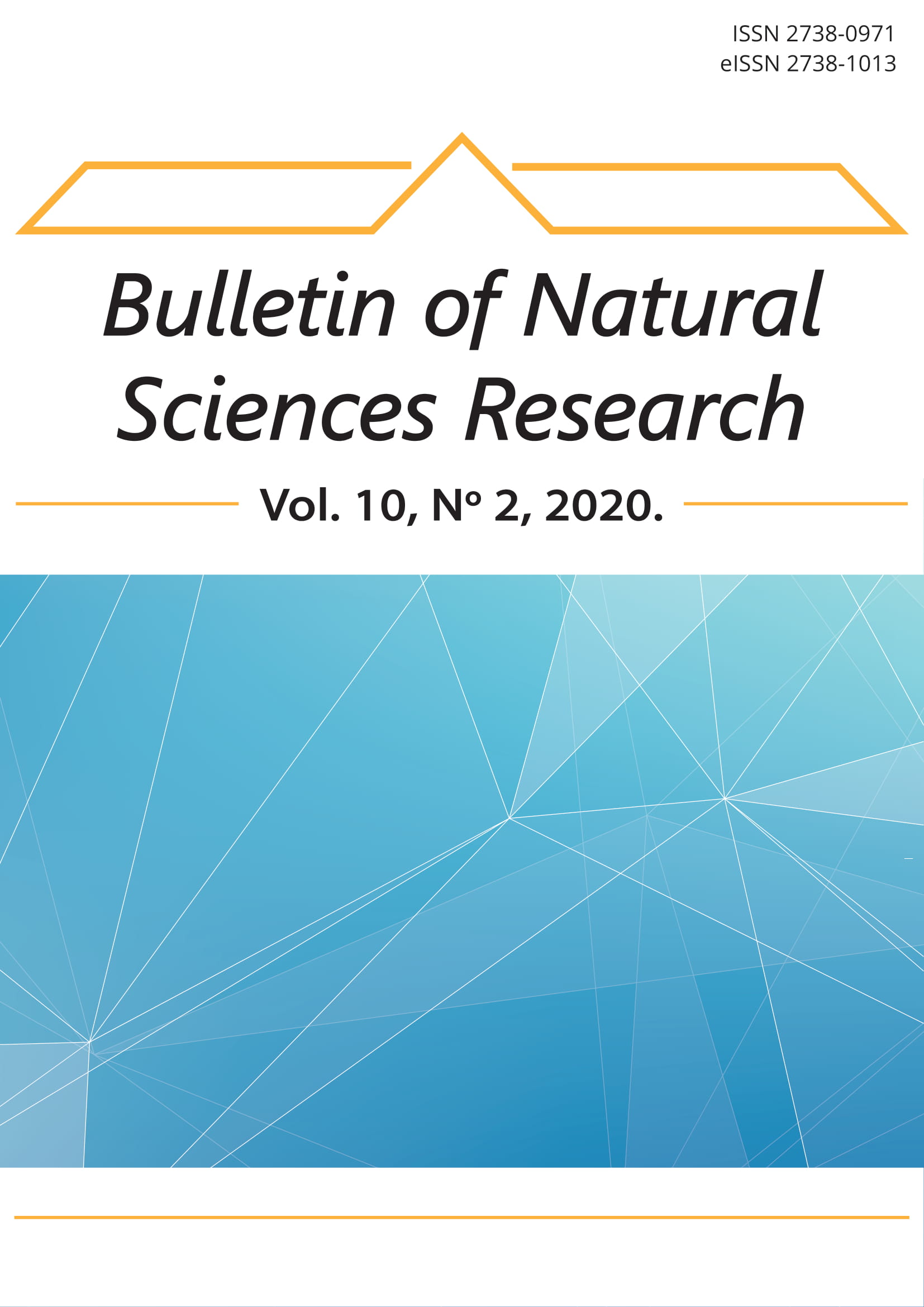SPECTROPHOTOMETRIC DETERMINATION OF ASCORBIC ACID BY HORSERADISH PEROXIDASE
Abstract
L-ascorbic acid is one of the essential nutrients and most common food supplements, fortificants, and preservatives. It is commercially available as solutions, drops, tablets, capsules, crystal powder, beverage mixtures, multivitamin formulations, and multi antioxidant formulations. The usual daily dose is from 25 mg to 1.5 g. Ascorbic acid is a distinctly reducing agent with low redox potential (0.18 and 0.08 V at pH 4.5 and 6.4, respectively). Based on ascorbate property, numerous methods for its quantitative determination are developed, from titrimetric, electrochemical, and chromatographic methods, to fluorometric and kinetic ones. Enzyme peroxidase is interfered with by ascorbic acid, which decreases the oxidation speed of its co-substrates during hydrogen peroxide decomposition by peroxidase. Absorbance changes at the wavelength of corresponding reagents are in correlation with ascorbate concentration. During this study, benzidine and o-tolidine have been used as chromogenic reagents. Reaction conditions were optimized for various buffer systems, calibration curves were constructed, and limits of detection (0.04 μmol/L) and quantification (0.12 μmol/L) were calculated. Using calibration charts, it was possible to detect ascorbic acid within limits from 0.4 to 10 μmol/L. The optimized method was applied for the determination of ascorbic acid in pharmaceutical products. The method was characterized by exceptional sensitivity and accuracy, but only for preparations not containing substances that affect enzyme peroxidase.
References
Abdelmageed O. H., Khashaba P. Y., Askal H. F., Saleh G. A., & Refaat I. H. 1995. Selective spectrophotometric determination of ascorbic acid in drugs and foods. Talanta, 42(4), pp. 573-579. doi.org/10.1016/0039-9140(95)01449-L
Arnao M. B., Cano C., Hernandez-Ruiz J., Garcia-Canovas F., & Acosta M. 1996. Inhibition by l-ascorbic acid and other antioxidants of the 2,2′-azino-bis(3-ethylbenzthiazoline-6-sulfonic acid) oxidation catalyzed by peroxidase: A new approach for determining the total antioxidant status of foods. Analytical Biochemistry, 236(2), pp. 255-261. doi.org/10.1006/abio.1996.0164
Backheet E. Y., Emara K. M., Hassan F. Askal H. F., & Saleh G. A. 1991. Selective spectrophotometric method for the determination of ascorbic acid in pharmaceutical preparations and fresh fruit juices. Analyst, 116, pp. 861-865 doi:10.1039/AN9911600861
Bagirova N. A., Shekhovtsova T. N., & van Huystee R. B. 2001. Enzymatic determination of phenols using peanut peroxidase. Talanta, 55(6), pp. 1151-1164. doi.org/10.1016/S0039-9140(01)00544-6
Hernandez-Ruiz, J., Arnao M. B., A. N. P. Hiner A. N. P., Garsia-Canovas F., & Acosta M. 2001. Catalase-like activity of horseradish peroxidase: relationship to enzyme inactivation by H2O2. Biochem. J., 354(1), pp. 107-114. doi.org/10.1042/bj3540107
Kapur A., Hasković A., Čopra-Janićijević A., Klepo, L., Topčagić A., Tahirović, I., & Sofić, E. 2012. Spectrophotometric analysis of total ascorbic acid content in various fruits and vegetables. Bulletin of the Chemists and Technologists of Bosnia and Herzegovina 38, pp. 39-42.
Krieg, R., & Halbhuber K. J., 2010. Detection of endogenous and immuno-bound peroxidase – The status quo in histochemistry. Progress in Histochemistry and Cytochemistry, 45(2), pp. 81-139. doi.org/10.1016/j.proghi.2009.11.001
Martinello F., & Da Silva E. L. 2006. Mechanism of ascorbic acid interference in biochemical tests that use peroxide and peroxidase to generate chromophore. Clinica Chimica Acta, 373(1-2), 108-116. doi.org/10.1016/j.cca.2006.05.012
Mittler, R., 2002. Oxidative stress, antioxidants, and stress tolerance. Trends in Plant Science, 7(9), pp. 405-410. doi.org/10.1016/S1360-1385(02)02312-9
Moghadam M. R., Dadfarnia S., Shabani A. M. H., & Shahbazikhah P. 2011. Chemometric-assisted kinetic spectrophotometric method for simultaneous determination of ascorbic acid, uric acid, and dopamine. Analytical Biochemistry 410(2), pp. 289-295. doi.org/10.1016/j.ab.2010.11.007
Official Methods of Analysis of AOAC International. 1995. Chapter 45, Method 80, 16th ed.
Ozyurek M., Guclu K., Bektasoglu B., & Apak R. 2007 Spectrophotometric determination of ascorbic acid by the modified CUPRAC method with extractive separation of flavonoids–La(III) complexes. Analytica Chimica Acta 588(1), pp. 88-95. doi.org/10.1016/j.aca.2007.01.078
Pandey V. P., & Dwivedi U. N. 2011. Purification and characterization of peroxidase from Leucaena leucocephala, a tree legume. J. Mol. Catal. B: Enzym., 68(2), pp. 168-173. doi.org/10.1016/j.molcatb.2010.10.006
Pereira A. V., & Fatibello-Filho O. 1997. Flow injection spectrophotometric determination of L-ascorbic acid in pharmaceutical formulations with on-line solid-phase reactor containing copper (II) phosphate1 Analytica Chimica Acta 366(1–3), pp. 55-62. doi.org/10.1016/S0003-2670(97)00660-0
Rodriguez-Lopez J. N., Hernandez-Ruiz J., Garcia-Canovas F., Thornley R. N. F., Acosta M., & ArnaoM. B. 1997. The Inactivation and Catalytic Pathways of Horseradish Peroxidase with m-Chloroperoxybenzoic acid. Biol. Chem., 272, pp. 5469-5476. doi.org/10.1074/jbc.272.9.5469
Shekhovtsova T. N., Muginova S. V., Luchinina J. A., & Galimova A. Z. 2006. Enzymatic methods in food analysis: determination of ascorbic acid Analytica Chimica Acta, 573-574, pp. 125-132. doi.org/10.1016/j.aca.2006.05.015
Thompson R. Q. 1987. Peroxidase-based colorimetric determination of L-ascorbic acid. Anal. Chem. 59(8), pp. 1119–1121. doi.org/10.1021/ac00135a011
Vajgand V. 1986. Analitika, Rad, Beograd, 37.
Wen, B., & Moore D. J., 2011. Bioactivation of glafenine by human liver microsomes and peroxidases: identification of electrophilic iminoquinone species and GSH conjugates. drug metabolism and disposition, 39(9), pp. 1511-1521. doi.org/10.1124/dmd.111.039396
White-Stevens R. H., 1982. Interference by ascorbic acid in test systems involving peroxidase. I. Reversible indicators and the effects of copper, iron, and mercury. Clinical Chemistry, 28(4), pp 578–588. doi.org/10.1093/clinchem/28.4.578
Zhu M., Huang X., Li J., & Shen H. 1997. Peroxidase-based spectrophotometric methods for the determination of ascorbic acid, norepinephrine, epinephrine, dopamine, and levodopa. Analytica Chimica Acta 357(3), pp. 261-267. doi.org/10.1016/S0003-2670(97)00561-8
Authors retain copyright and grant the journal right of first publication with the work simultaneously licensed under a Creative Commons Attribution License that allows others to share the work with an acknowledgement of the work's authorship and initial publication in this journal.

